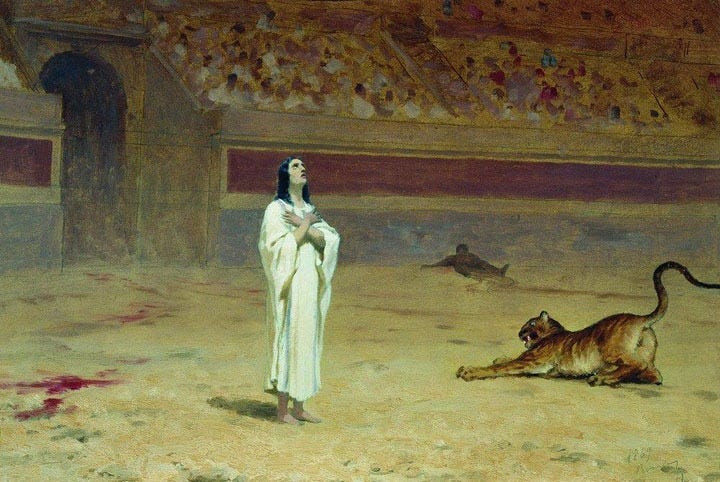The early church fathers were acquainted with ghosts and ghostly visions, as the previous entries on ghosts in Old and New Testaments make clear. Two notable examples of ghosts in the literature of the early church show how they tended to function and be regarded.
It’s important at this point to note that visions of the dead in dreams (oneiric apparitions) and waking sightings of ghostly figures were both considered types of spectral encounters. The deep meaning attached to dream-figures, particularly of real people delivering important messages, was considered not merely a psychological byproduct of deep sleep, but as supernatural events. We’ll get to this more fully when we discuss Augustine.
Our first ghost appears in The Passion of Saints Perpetua and Felicity, an important early account of martyrdom. Prior to their execution in Carthage on March 7th 203, Perpetua experiences something unusual. While she is waiting in prison, the name of Perpetua’s dead little brother Dinocrates comes to her mind unbidden during prayer, and she thinks this is significant. That night, she has a vision of him:
I beheld Dinocrates coming forth from a dark place, where were many others also; being both hot and thirsty, his raiment foul, his color pale; and the wound on his face which he had when he died. This Dinocrates had been my brother in the flesh, seven years old, who being diseased with ulcers of the face had come to a horrible death, so that his death was abominated of all men. For him therefore I had made my prayer; and between him and me was a great gulf, so that either might not go to the other. There was moreover, in the same place where Dinocrates was, a font full of water, having its edge higher than was the boy's stature; and Dinocrates stretched up as though to drink. I was sorry that the font had water in it, and yet for the height of the edge he might not drink.
She prays for her brother every day and night, that he may be released from this torment. It is interesting that the language clearly evokes the story of Dives and Lazarus, suggesting the impossibility of Dinocrates getting any relief in the afterlife. Nonetheless, Perpetua continues to pray for him.
Days later, she has another vision:
I saw that place which I had before seen, and Dinocrates clean of body, finely clothed, in comfort; and the font I had seen before, the edge of it being drawn to the boy's navel; and he drew water thence which flowed without ceasing. And on the edge was a golden cup full of water; and Dinocrates came up and began to drink therefrom; which cup failed not. And being satisfied he departed away from the water and began to play as children will, joyfully.
And I awoke. Then I understood that he was translated from his pains.
This is a powerful scene for such an important early Christian text. Here we have a vision of the dead that suggests the fate of the departed in the otherworld, complete with an image of living water that “flowed without ceasing.” The state of Dinocrates, and the ability of Perpetua’s intercessory prayers to free him from it, is a powerful early witness to Purgatory and prayers for the dead.
These appearances of the dead in dreams—almost always pregnant with meaning and Christian symbolism—are repeated in ghostly and visionary literature for the next thousand years and beyond.
We find another ghostly dream vision in the apocryphal Acts of Paul and Thecla, composed in the 2nd century. (The linked translation is by MR James, master of the classic ghost story.) St. Thecla, inspired by Paul to pursue a life of virginity, survives various attempts to execute her for her faith.
After her sentence of death, she is given into the care of a “rich queen” name Tryphaena in order to preserve her virginity until execution. The authorities attempt to feed Thecla to the lions, but they refuse to attack, instead licking her feet.
After this first attempt to kill her, Thecla is returned to the keeping of Tryphaena, whose had lost a daughter named Falconilla. The daughter comes to Tryphaena in a dream, saying:
“Mother, thou shalt take in my stead Thecla the stranger that is desolate, that she may pray for me and I be translated into the place of the righteous.”
When therefore Tryphaena received her after the procession, she alike bewailed her because she was to fight the beasts on the morrow, and also, loving her closely as her own daughter Falconilla; and said: Thecla, my second child, come, pray thou for my child that she may live for ever; for this have I seen in a dream. And she without delay lifted up her voice and said: O my God, Son of the Most High that art in heaven, grant unto her according to her desire, that her daughter Faleonilla may live for ever. And after she had said this, Tryphaena bewailed her, considering that so great beauty was to be cast unto the beasts.
Tryphaena grows fond of Thecla, regarding her as a second daughter. When Thecla survives a second attempt to kill her, the queen comes to believe in Thecla's God and believes her daughter’s soul has been redeemed by Thecla’s prayers. Her whole household converts and Thecla goes on her way.
Thus do we see intercessory prayer for the dead and a suggestion of purgatory in another piece of early Christian literature. In these two accounts, ghosts act as witnesses to the state of the dead in the afterlife, as they plead for prayers to move them on to salvation. It's a motif we'll see repeated for centuries, from ghosts both oneiric and phantasmal. Even more interesting is that we have clear early indications of purgatory and prayers for the dead a full millennium before some scholars (such as le Goff) argue that purgatory was "invented."





